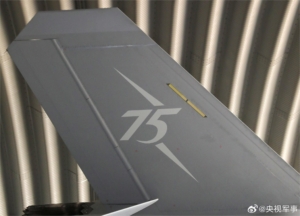A first official photo of China’s new F-35 clone!
November 6, 2024

The official social media account of the Chinese People’s Liberation Army (PLA) News Media Center (‘China Bugle’) has released a new photo of the J-35A stealth fighter, hinting that the aircraft might make its public debut at the upcoming Airshow China 2024, which is to be held in Zhuhai, in China’s Guangdong Province from 12-17 November. This marked the first time that the J-35A has appeared on an official media platform.
The aircraft in the photo wore the number ’75’ on its vertical fin, celebrating that this year marks the 75th anniversary of the founding of the People’s Liberation Army (PLA) Air Force on 11 November.

Development of China’s second fifth generation fighter (after the Chengdu J-20) began in about 2007, when the Shenyang Aircraft Design Institute (601 Institute) began developing the Project 310 multi-role stealth fighter as a private venture, for export. The aircraft reportedly benefited from technology from the F-22 and F-35, acquired via espionage. The aircraft bore some resemblance to the F-22, albeit with more conventional engine nozzles. This design was briefly redesignated as the F-60, and later as the FC-31. China has always denied claims of espionage, and the Aviation Industry Corporation of China (AVIC) insists that the J-35A is a “new type of stealth fighter jet independently developed by China.”
Static tests began at the 623 Institute in June 2012, and the first FC-31 prototype (31001) made its first flight on 31 October 2012, powered by two Russian RD-33 turbofans. The FC-31 featured a single internal weapons bay accommodating up to 6 AAMs or 50-kg class PGMs, and could carry larger, heavier weapons on six underwing hardpoints. The FC-31 made its Zhuhai air show debut, in an all-black livery, ten years ago in November 2014.
The aircraft was subsequently re-engined with two upgraded WS-21 turbofan engines, flying in its new form on 1 July 2016.
A subsequent prototype (31003) was redesigned, and this made its first flight on 23 December 2016, powered by higher thrust WS-13E engines.
The new aircraft incorporated a one-piece canopy, a new wide-angle holographic HUD, a longer and fatter fuselage incorporating more composite materials, a bigger internal weapons bay, larger wing area, reshaped F-35 style tail fins and cropped wing and horizontal stabilizer tips similar to those on the F-22. This revised design was renamed as the J-31 in early 2024, indicating that it was expected to enter service with the PLA. This aircraft acted as a stepping stone to the later J-35.
A much redesigned variant was selected by the PLA Navy to serve as its next generation carrier-based stealth fighter. This, the J-35 (Project 1810) featured a raised cockpit, a forward opening one-piece canopy with handholds for catapult launches, and a deeper spine. These provided a better view over the nose and greater internal fuel capacity. The aircraft also had longer-span folding wings, bigger tailfins, a carrier-capable undercarriage with twin nosewheels and a retractable arresting hook. The tailplanes were moved aft for improved low speed handling characteristics. The new variant was powered by the new WS-19 Huangshan turbofan engines, possibly with thrust vectoring nozzles, and features a diverterless supersonic inlet (DSI) that diverts sluggish boundary layer airflow away from the engine, while slowing air from supersonic to subsonic speeds before it enters the engine.
All of this was intended to prepare the J-35 for service on board the new Type 003 Fujian aircraft carrier. The J-35 prototype (350001) made its maiden flight on 29 October 2021. Under the skin, the J-35 promises to have some sensor-fusion and advanced data processing capabilities, and to be able to hand-off targets to other aircraft and weapons.
Although the F-35 is assumed to be far ahead in stealth coatings and materials, the sleek J-35 may eventually be able to supercruise, when powered by the indigenous WS-19 turbofan engine. Supercruise was once said by Lockheed Martin to be a defining fifth generation characteristic, until the F-35A proved unable to achieve it!
There were already rumours that a dedicated land-based J-35A variant was being developed for PLA Air Force service. This lacked many of the ‘carrier’ features of the J-35, including the arrestor hook, twin nosewheels and enlarged folding wings. A test airframe was reported to have been transported to the 623 Institute for static tests in March 2022, and the first J-35A prototype made its maiden flight from Shenyang on 26 September 2023. It is the J-35A that is making its debut at Airshow China.
The FC-31, J-35 and J-35A all use the same Gyrfalcon name.
The first export customer for the J-35A is expected to be the Pakistani Air Force, a regular and long-standing customer for Chinese-made combat aircraft. On 2 January 2024, Pakistan Air Force commander Air Chief Marshal Zaheer Ahmed Baber announced that: “The foundation for acquiring the J-31 [SiC] stealth fighter aircraft has already been laid, which is all set to become part of the Pakistan air force fleet in the near future.” An initial order for 36 aircraft is expected.
















